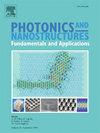Optimization strategy of ultra-compact metasurface-based filter ordering on sensors for improved spectral retrieval
IF 2.9
3区 物理与天体物理
Q3 MATERIALS SCIENCE, MULTIDISCIPLINARY
Photonics and Nanostructures-Fundamentals and Applications
Pub Date : 2025-06-03
DOI:10.1016/j.photonics.2025.101409
引用次数: 0
Abstract
CMOS technologies can provide miniature filters with few-nm passband in the visible, much suited to on-chip spectrometers and hyperspectral imaging. However, crosstalk can become challenging and degrade spectral retrieval at the smallest sizes. A filter/metasurface bank design is a first demanding step for this scope, playing with in-plane patterns/“atoms”. For a miniature device of 10–100 small pixels, each 1–3 μm wide, the filters finite extent incurs an extra penalty: cross-talk between neighbor pixels, hard to minimize through electromagnetic tools. A distinct and useful minimization suited to the CMOS context is then to select the arrangement of N filters on the array to privilege the less penalizing neighbor pairs. This amounts to a path selection problem in the N×(N−1) space of the inter-micro-filter cross-talks. We evaluate the resulting benefit in terms of the condition number of the system’s spectral function matrix, the basic ingredient for spectral retrieval. In one dimension, we find that small arrays can be tackled by brute force up to N∼15 filters, but a minimization through a simply weighted proxy, a summed cross-talk combination, is more advantageous beyond. In two-dimensions, the topology only partly changes the trend. Relevant examples of infinite and finite filters based on amorphous silicon and silica are also provided to justify the choice of a rather broad cross-talk distribution in the inter-filter space. Gains of c−1∕〈c−1〉=1.5–2.5 on the inverse of the condition number c (and thus the accuracy of spectral retrieval) emerge from the study.
基于超紧凑超表面的传感器滤波排序优化策略,提高光谱检索效率
CMOS技术可以在可见光范围内提供几纳米通带的微型滤波器,非常适合片上光谱仪和高光谱成像。然而,串扰可能变得具有挑战性,并且会降低最小尺寸的光谱检索。过滤器/超表面库设计是这个范围的第一步,使用平面内模式/“原子”。对于10-100个 小像素的微型设备,每个1-3 μm宽,滤波器的有限范围会带来额外的损失:相邻像素之间的串扰,很难通过电磁工具最小化。然后,适合CMOS环境的一个独特而有用的最小化方法是选择阵列上N个滤波器的排列,以优先考虑惩罚较小的邻居对。这相当于在微滤波器间串扰的nx (N−1)空间中的路径选择问题。我们根据系统的谱函数矩阵的条件数来评估由此产生的效益,谱函数矩阵是谱检索的基本成分。在一维中,我们发现小数组可以通过蛮力处理多达N ~ 15个滤波器,但通过简单加权代理(求和串扰组合)进行最小化更有利。在二维中,拓扑结构只能部分地改变趋势。还提供了基于非晶硅和二氧化硅的无限和有限滤波器的相关示例,以证明在滤波器间空间中选择相当宽的串扰分布是合理的。在条件数c的逆上,c−1∕< c−1 > = 1.5-2.5的增益(因此光谱检索的准确性)从研究中得到。
本文章由计算机程序翻译,如有差异,请以英文原文为准。
求助全文
约1分钟内获得全文
求助全文
来源期刊
CiteScore
5.00
自引率
3.70%
发文量
77
审稿时长
62 days
期刊介绍:
This journal establishes a dedicated channel for physicists, material scientists, chemists, engineers and computer scientists who are interested in photonics and nanostructures, and especially in research related to photonic crystals, photonic band gaps and metamaterials. The Journal sheds light on the latest developments in this growing field of science that will see the emergence of faster telecommunications and ultimately computers that use light instead of electrons to connect components.

 求助内容:
求助内容: 应助结果提醒方式:
应助结果提醒方式:


